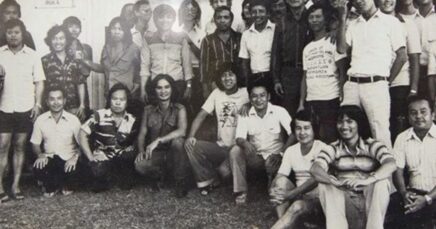Watch Video
Read Article
In April of 1998, the Patrick Stevedores corporation sacked all of its stevedoring workers in the dead of night.
Security guards wearing balaclavas accompanied by barely-restrained attack dogs appeared on the wharfs of Australia. They were there to lock dockworkers out of their place of work.

In its determination to de-unionise its workforce, Patrick’s had undergone a “restructuring”, and recruited non-union workers to take the places of union members.
Patrick’s, with the backing of the Howard Government, had declared war on the Maritime Union of Australia – the MUA.

In the weeks to come, MUA members – the wharfies – would face the full force of Patrick’s and the Government. The wharfies did not back down, they did not waver, and they won.

This is their story.
The Howard Government had strong unions like the MUA in its sights when it introduced new industrial relations laws in 1996. These laws sought to weaken the role of unions as the collective organisations of workers.
Cabinet papers released from this period suggest that the Howard Government was planning for a showdown with the MUA from early in its first term.
Why the MUA? Well, the Maritime Union has a strong history of activism and solidarity – wharfies have come together in their union time and again to win vital rights for their industry.
We all know what Howard thought of that.
In the months leading up to the Maritime Dispute, Patrick’s put extensive plans in place for its campaign against the MUA – encouraged by the Howard Government, and with its active support.
There was even a secret operation to recruit a non-union workforce and to try and secretly train them in Dubai.
The MUA was tipped off about this plan.
In an act of global solidarity among Maritime Workers, the International Transport Workers’ Federation remonstrated with local authorities, and the visas of the trainees were revoked.
But Patrick’s were determined – they wanted the MUA off the docks.
Managing Director of Patrick’s at the time, Chris Corrigan, later said that his aim with the lock out was:
“as in all business pursuits, the aim of enhanced returns by improving business practices and client service”
We all know what that is code for.
After the lockout of wharfies began, the MUA sprang into action. Community pickets were organised and a legal challenge launched.

The MUA was led by the legendary John Coombs – and its strength came from its members, wharfies all across Australia who refused to be intimidated.

The response in support of the wharfies was emphatic. Across the country unionists from a variety of trades and industries joined MUA members to protest their treatment. ACTU President Jennie George played a leading role in organising and supporting these community actions.
This community support was even more important after the second week of the struggle, when a series of injunctions began to be handed down banning MUA members and officials from the pickets.

Trades and Labour Councils put together phone trees, and whenever Patrick’s was trying to move cargo in or out through the community picket lines, activists were mobilised on short notice to reinforce the protests.
Union after union leant their support, both in personnel, and financially. Union members and community supporters popularised the chant across the country: “MUA: here to stay!”
Eventually, public opinion put pressure on Patrick’s and a court decision meant the MUA members returned to work.
It had been found that Patrick’s had conspired with others to illegally sack its workers for being union members.
Wharfies – proud union members – triumphantly marched back into their workplaces.

The MUA’s victory in 1998 was an inspiring example of how unions can win even against the toughest of opposition.
For a generation of unionists, it was a defining struggle that proved the strength of our opponents, and the power of our solidarity.
Conservative governments, and anti-union bosses, they come and go.
But the MUA is here to stay.
Watch MUA Documentary
You can watch the special MUA documentary on the dispute here.
Images of the Struggle
These photographs of the 1998 Dispute were recently located in the ACTU’s collection







